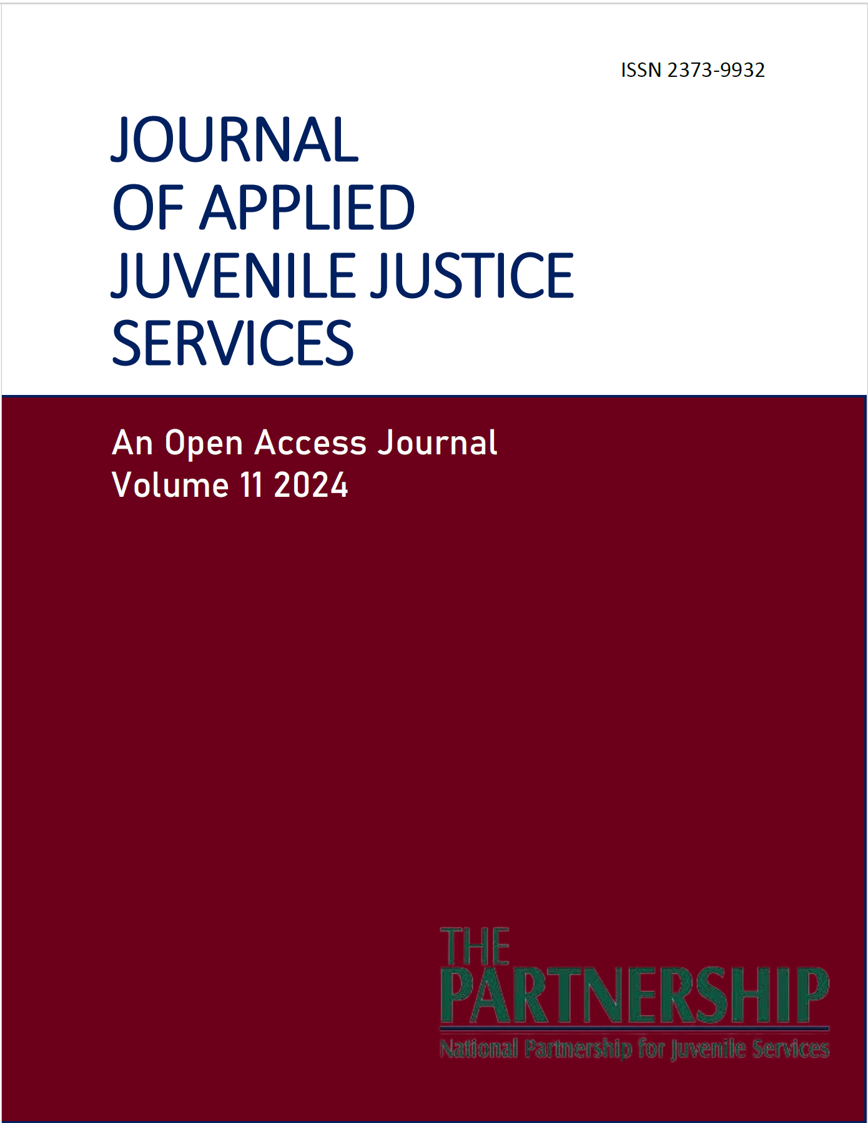Factors That Influence Employment for Justice-Involved Youth: The Juvenile Justice Work Qualifications Scale
Highlights
- Important to understand employer perspectives toward justice-involved youth.
- This study investigated the psychometric properties of a new measure.
- Analyses measured factor structure, reliability, and group differences.
- Four-factor structure, strong reliability, and company size differences.
- Further replication research on this instrument is needed.
Abstract
Understanding employer perspectives toward necessary work qualifications for justice-involved youth and aligning transition planning and employment preparation activities with these perspectives is integral in increasing employment rates and decreasing recidivism for this population. This study investigated the psychometric properties of the Juvenile Justice Work Qualifications Scale (JJ-WQS), a measure of the importance of work qualifications for entry level employees previously involved in juvenile services from the perspective of employers. Analyses explored and confirmed the scale’s factor structure, measured internal consistency, and examined group differences based on geographic location, business structure, and business size. Results indicated evidence of a four-factor structure, strong internal consistency, and mean differences based on company size. Implications for both research and practice are discussed including the need for further replication research on this instrument to confirm these findings and generate additional evidence of its efficacy with entry-level employers to inform supports for justice-involved youth in preparing for employment.
Keywords
Juvenile Justice, Work Qualifications, Employers’ Perspectives, Workforce Development
INTRODUCTION
Formerly incarcerated youth have a high likelihood of continuing criminal behavior in adolescence and into young adulthood (Brame et al., 2018). Youth displaying criminal behavior may exhibit continued criminal behaviors, at least to some degree, and
hinder their future work, school, and family endeavors as adults (Carter, 2019). Relative to continued criminal activity, at least 45% of justice involved youth are likely to be arrested for another crime after release (Wilson et al., 2003). Specifically, states have reported slightly more than half of youth who are incarcerated recidivate within one year of release. Being a justice-involved youth is a strong predictor for school dropout (Kirk & Sampson, 2013; Na, 2017) or even returning to a school setting postrelease (Cavendish, 2014), with only eight percent of justice-involved youth earning any type of high school diploma in the three years post-release (Foley, 2001).
A primary goal of community reentry for youth involved with juvenile services is reduced recidivism (Griller Clark & Mathur, 2014; Griller Clark et al., 2011), both for successful individual outcomes and for the societal impact. The Justice Policy Institute (2020) estimates the cost of secure confinement of a justice-involved youth at $588 per day, or $214,620 per year, which represented a 44% increase from 2014. In an econometric model, Cohen and Piquero (2009) estimated the value of reducing a high-risk 14-year old’s propensity for criminal behavior to be between $2.6 million and $5.3 million dollars. Improving the employment outcomes of this high-risk population would increase the individual’s chance of achieving positive adult roles. Additionally, higher employment rates increase local, state, and federal tax revenue and reduce the likelihood of recidivism specifically for justice-involved youth, saving victim, court, and future incarceration costs, along with public safety infrastructure costs. To this end, this study investigates the psychometric properties of the Juvenile Justice Work Qualifications Scale (i.e., JJ-WQS), a measure of the importance of work qualifications for justice-involved youth from the perspective of employers. What follows is a review of literature, a description of the study methodology, and a discussion of the findings.
Literature Review
Ashford and Gallagher (2019) found that successful community reentry that includes employment is a protective factor for justice-involved youth and can reduce recidivism. Research indicates that justice-involved youth are less likely to
find employment than their peers without justice involvement, though once they do find employment their satisfaction and outcomes are akin to their peers without previous justice system involvement (Carter, 2019; Latessa, 2012). The passage of the Workforce Innovation and Opportunity Act (Collins et al., 2021) has also emphasized the importance of job training, work experiences, and employment for high-risk youth, including justice-involved youth, to improve community reentry outcomes.
While research has focused on preparing justice-involved youth with the skills and behaviors needed to find and maintain employment upon exit, it is also important to understand the perspectives (i.e., attitudes, feelings, and past experiences) of employers toward hiring youth formerly involved with juvenile services to increase the likelihood that the skills being taught are in alignment with the needs and perspectives of employers. There have been some initial studies examining perspectives of employers and how they influence employment outcomes for justice-involved youth, including a study by Pham and colleagues (2015) who found that 58% of employers were either likely or very likely to hire individuals previously involved in the juvenile justice system. In an updated study more recently, Unruh and Colleagues (2023) found that 69% of employers surveyed were likely or very likely to hire these individuals.
Over-Representation and Stigma of Criminal History
Other studies have found that stigmas related to incarceration, race, and personal factors influenced the willingness of employers to interview and hire potentially qualified candidates (Decker et al., 2015). Youth with violent crimes were also less likely to be interviewed compared to youth with non-violent offenses (Griller Clark et al., 2020). In addition, experience with the criminal justice system combined with a history of mental health challenges further negatively influenced perceptions (Batastini et al, 2017). Employers have also been shown to be more willing to hire justice-involved youth if the crime was a mistake and not an indicator of future behavior (Mathur et al, 2023). Employer pers-pectives on hiring justice-involved youth are important because positive employer attitudes are associated with improved outcomes for both finding and maintaining meaningful employment (Joseph et al., 2017) with reduced recidivism.
Black and Indigenous populations are overrepresented in juvenile justice settings as compared to their white counterparts. Specifically, 42% of all youth in juvenile facilities are Black compared to 14% in the general population under age 18 (Sawyer, 2019). Although small in numbers, 3% of Native girls and 1.5% of Native boys are in juvenile facilities even though they comprise only 1% of all youth (Sawyer, 2019). Researchers estimate that 20% of youth in correctional facilities represent lesbian, gay, bisexual, transgender, queer or questioning and other sexual identities (LGBTQ+) youth compared to four to six percent of the general youth population (Irvine & Canfield, 2015). The intersection of involvement in juvenile services, race/ethnicity, disability, and other marginalized populations creates a critical need to understand the most important work qualifications to prepare justice-involved youth accordingly.
Work Qualifications
In addition to understanding how likely employers are to hire justice-involved youth, understanding factors influencing the likelihood of hiring justice-involved youth is just as important. For example, justice-involved youth who are prepared with specific work qualifications (e.g., previous work experience, educational attainment, job skills, and “soft skills”) may be more likely to be hired than those without these qualifications. Understanding what work qualifications are more desired by employers can impact how justice-involved youth are prepared for employment and community reentry, as research has indicated that higher work qualifications increase employability for individuals convicted of a nonviolent offense (Cerda et al., 2015). These work qualifications may also mitigate social stigmatization in addition to increasing employability (Varghese et al., 2010).
Other studies have supported the idea that a lack of qualifications from justice-involved youth hinders employment prospects and that this lack of qualifications may be higher among this population than in the general population (Varghese et al., 2009, 2010). Even for those who have yet to be convicted, lower levels of qualifications were associated with fewer job prospects (Peoples, 1995). It has long been understood that formerly incarcerated individuals are perceived to experience challenges with language barriers, communication skills, and social skills (Rahill-Beuler & Kretzer, 1997); lower educational attainment than individuals without a criminal history (Travis & Petersilia, 2001); and uneven and fragmented work histories (Holzer et al., 2003). These factors alone would understandably limit employment opportunities, but coupled with lack of appropriate qualifications can prove ever more burdensome.
There is initial evidence in the literature to suggest that qualifications influence hiring decisions, particularly when the qualifications are especially high. Swanson et al. (2012) found in their research that 42% of employers who had previously hired an individual who had been convicted of a criminal offense indicated that their qualifications for the job were the primary factor influencing their hiring decision. Other research has indicated that hiring an individual with relevant job skills was “very important” or “important” for 98% of the employers surveyed and professional qualifications or certifications were “very important” or “important” to 65% of employers (Haslewood-Pocsik et al., 2008). This study also found that personal attributes, or “soft skills” (e.g., honesty, reliability, and punctuality; Swanson et al., 2012), were rated almost as highly as job skills, suggesting that certifications alone are not the only determining factor.
Holzer et al. (2004) found that employers were more willing to hire formerly incarcerated individuals with work experience compared to those with no previous work experience. Varghese et al. (2009), in their examination of the interactive effects of ethnicity, criminal history, and job qualifications on employability, found that qualifications played a significant role in hiring recommendations and that formerly incarcerated individuals with higher qualifications were significantly more likely to be recommended for employment. Varghese et al. (2010) also found that formerly incarcerated applicants with higher qualifications received more workplace recommendations than those with lower qualifications. These studies also both found that higher levels of qualifications increased employment recommendations at higher rates for individuals with lower level (i.e., non-criminal) offenses.
In general, higher levels of work qualifications lead to improved employment outcomes for formerly incarcerated individuals (Harrison and Schehr 2004; O’Connell et al. 2007). While these qualifications may not completely outweigh the negative effects of having a criminal or misdemeanor charge, there is evidence to suggest that higher rates of qualifications may at least mitigate some of the negative impact. Varghese et al. (2009) found that qualifications were not only impactful in increasing the employability of formerly incarcerated individuals, but also increasing employment-related recommendations, particular for those with misdemeanor as opposed to criminal charges. Increasing the work qualifications for justice-involved youth may be one tangible pathway to mitigate bias in the employment process, improve community reentry outcomes, and ultimately reduce recidivism rates.
Current Study
Increasing the levels of work qualifications for justice-involved youth should be a priority in the effort to increase employment and decrease youth recidivism. To do this, it is necessary to understand what qualifications would be most influential on the decision of a potential employer to hire justice-involved youth. The purpose of this study, therefore, was to develop and validate the JJ-WQS and examine its psychometric properties. Developing this new measure could help support transition programs and Vocational Rehabilitation (VR) counselors in deter-mining the most effective strategies for preparing justice-involved youth for employment and commu-nity reentry. Specifically, this study sought to answer the following research questions:
1. Does the JJ-WQS demonstrate acceptable construct validity?
2. Does the JJ-WQS demonstrate acceptable internal consistency?
3. What do group differences between geographic region and business size and structure suggest about the differences in work qualifications deemed most important?
METHOD
To continue reading, download the full open access article.



